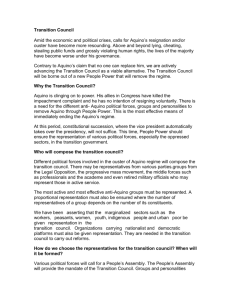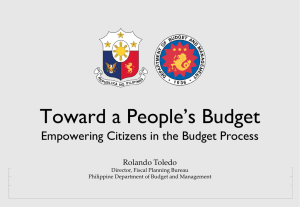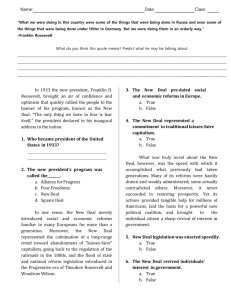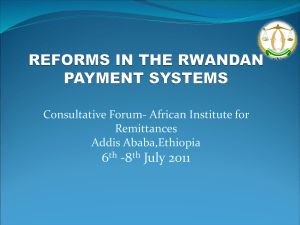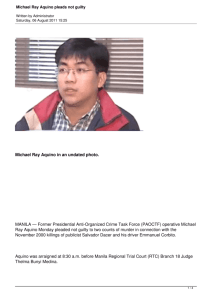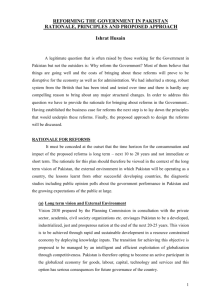Presentation by Hon. Florencio B. Abad
advertisement
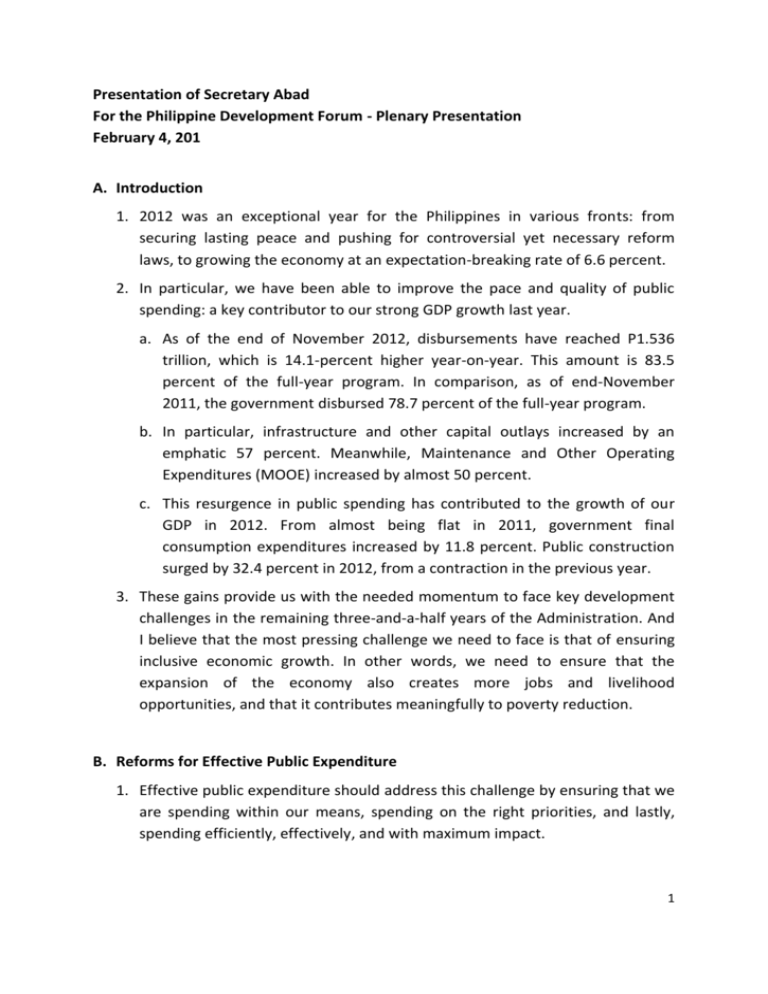
Presentation of Secretary Abad For the Philippine Development Forum - Plenary Presentation February 4, 201 A. Introduction 1. 2012 was an exceptional year for the Philippines in various fronts: from securing lasting peace and pushing for controversial yet necessary reform laws, to growing the economy at an expectation-breaking rate of 6.6 percent. 2. In particular, we have been able to improve the pace and quality of public spending: a key contributor to our strong GDP growth last year. a. As of the end of November 2012, disbursements have reached P1.536 trillion, which is 14.1-percent higher year-on-year. This amount is 83.5 percent of the full-year program. In comparison, as of end-November 2011, the government disbursed 78.7 percent of the full-year program. b. In particular, infrastructure and other capital outlays increased by an emphatic 57 percent. Meanwhile, Maintenance and Other Operating Expenditures (MOOE) increased by almost 50 percent. c. This resurgence in public spending has contributed to the growth of our GDP in 2012. From almost being flat in 2011, government final consumption expenditures increased by 11.8 percent. Public construction surged by 32.4 percent in 2012, from a contraction in the previous year. 3. These gains provide us with the needed momentum to face key development challenges in the remaining three-and-a-half years of the Administration. And I believe that the most pressing challenge we need to face is that of ensuring inclusive economic growth. In other words, we need to ensure that the expansion of the economy also creates more jobs and livelihood opportunities, and that it contributes meaningfully to poverty reduction. B. Reforms for Effective Public Expenditure 1. Effective public expenditure should address this challenge by ensuring that we are spending within our means, spending on the right priorities, and lastly, spending efficiently, effectively, and with maximum impact. 1 a. On fiscal discipline, we are on track meeting for our fiscal consolidation goals, particularly the targeted deficit-to-GDP ratio of 2 percent by this year. b. Allow me to flesh out our reforms in pursuit of allocative efficiency and operational effectiveness in public expenditure management. 2. On budgetary prioritization, this is our core framework: the Aquino Social Contract with the Filipino People. We have been working to focus public funds on five key result areas of this Social Contract, as shown in the screen. 3. When we assumed office in 2010, we introduced the Zero-Base Budgeting approach to eliminate inefficient, ineffective, and irrelevant programs and projects, and to re-channel funds to priority social programs. a. In 2011, President Aquino issued Executive Order No. 43 which defined the five Key Result Areas of his Social Contract that I outlined earlier. This EO was also an instruction to align the Budget along these five KRAs. b. We introduced the Program Budgeting Approach last year as we were crafting the 2013 Budget to further deepen the prioritization of the Budget for key programs under these five Key Result Areas. c. This year, we will jump-start the process of crafting the 2014 Budget by triggering a Cabinet-level discussion on the government’s priorities that should be funded for 2014 to 2016, and specifically for 2014. Along these priorities, we will ask the Cabinet to make commitments on the programs and projects that they will deliver through their respective agencies, and in close coordination with their counterparts. These decisions and commitments will be summarized in a Budget Priority Framework, which will guide all departments in strategically planning their activities and crafting their budgets for 2014. 4. We have also introduced reforms to ensure the fast and efficient implementation of the budget and delivery of priority programs and projects. a. We started this by introducing the policy for the disaggregation of lumpsum funds into specific programs and projects. Lump-sum funds have not only begotten anomalies but have also slowed down budget execution. b. We also introduced innovations to speed up the procurement process. 2 We allowed departments to conduct bidding, short of award, even before the National Budget was approved by Congress. This allowed the awarding of contracts as early as the first working day of the year. Moreover, the work of expanding the Philippine Government Electronic Procurement System (PhilGEPS) continues. Just recently, we launched an electronic payment facility for the PhilGEPS Virtual Store. c. We also deployed Account Management Teams in key departments to address bottlenecks in the implementation of programs and projects. d. This year, a new system will take place: all appropriations will have a life span of one year. This improves the predictability of budget execution and government operations, as carry-over budgets will now become a thing of the past. e. These reforms—particularly the greater disaggregation of the Budget and the one-year validity of appropriations—pave the way for the onset of a new budgetary regime: by 2014, the General Appropriations Act will serve as the Budget Release Document. This will eliminate the redundant process of requesting, processing, and releasing budgetary allotments. 5. We also worked to ensure that each peso spent will lead to measurable results via stronger performance management and performance budgeting. a. We reviewed the implementation of the Organizational Performance Indicator Framework (OPIF). In particular, we sought to refine the outcomes and major final outputs of departments, ensuring that these are aligned with the priority outcomes under the Aquino Social Contract. b. We have also initiated the harmonization of all government performance management systems into a single Results-Based Performance Management System. President Aquino issued Administrative Order No. 25 that created a Task Force for the development of this harmonized system. c. We also pursued a new system of government incentives that is linked to measurable performance by agencies and individual civil servants: the Performance-Based Incentive System, which we are currently piloting. d. What we are basically trying to do is push for better planning and execution by public institutions. As part of the Budgetary Prioritization Framework process that I discussed earlier, we hope to introduce a system 3 of Performance Contracting at the Cabinet level. The creation of the Office of the Cabinet Secretary will also facilitate the introduction of this process. 6. On the financial side, we continue to implement our roadmap for Public Financial Management Reforms together with DoF-BTr and CoA. Of this roadmap, let me highlight: a. The Treasury Single Account, which should hopefully be installed by 2014. This will revolutionize our cash management operations and provide more reliability and predictability in budget releases, cash programming, and financial reporting. b. We are also installing a Government Integrated Financial Management Information System (GIFMIS), which will be a system that will provide realtime information on financial transactions. This GIFMIS will harmonize financial information systems of oversight and implementing agencies. For GIFMIS to work, we are also currently harmonizing our chart of accounts. C. Conclusion: Irreversibility of Reform, and Transparency & Participation 1. We remain committed to President Aquino’s Social Contract with the Filipino People. We believe that we can achieve inclusive economic growth by sticking to our formula that good governance is good economics. 2. However, we are aware that we face another important challenge from now to 2016: that of securing the irreversibility of our governance reforms. What does it entail to achieve this irreversibility? a. Obviously, we have to deeply embed good governance measures in the policies, institutions, and processes of government. b. We also have to ensure that our reforms actually bring immediate and substantial benefits to our people by way of adequate social and economic services, as well as inclusive growth. In other words, the reversal of such beneficial reforms will be costly, both politically and economically. c. This requires creating widespread and sustained demand for reforms from the people, particularly key stakeholders in civil society, the private sector, the academe, development partners, among others. 3. This need to strengthen the constituency for reform highlights the importance of greater transparency and participation in the budget process. 4 a. When we assumed office, among the first things that we did was engage our partners in civil society and establish principles for constructive engagement with them in the budget process. b. In the 2011 Budget—the first to be crafted under this Administration—we included a provision that requires agencies to disclose their budget information online: from their approved budgets to the status of implementing their programs and projects. c. We also introduced a process of Budget Partnership Agreements between government agencies and civil society organizations. From the original pilot set of six departments and three government firms, we expanded the pilot set to twelve departments and six GOCCs in crafting the 2013 Budget. d. We also leveraged technology to introduce greater transparency in the national budget. We launched a special webpage where releases from the Priority Development Assistance Fund of legislators are disclosed. We also launched a special budget advocacy website, the BudgetNgBayan.com e. As we were crafting the 2013 Budget, we, led by the Human Development Cluster, piloted an ambitious process of Bottom-Up Budgeting. Through this process, 595 of the country’s poorest municipalities created local poverty reduction plans, in consultation with civil society organizations and grassroots communities in their localities. 4. It has been two-and-a-half years since the Aquino administration started. Our journey in pursuit of our reform agenda has not been without difficulty, but our efforts are now bearing fruit. We have the momentum now. a. To move us forward even further, one thing should continue to inspire us: that same inspiration that installed President Aquino in 2010. b. That is People Power, a paradigm for progress through the active and meaningful participation of citizens in governance: not just in the streets or in the voting booths, but in the less dramatic but important day-to-day challenges of governance. 5. Thank you and good morning. 5
